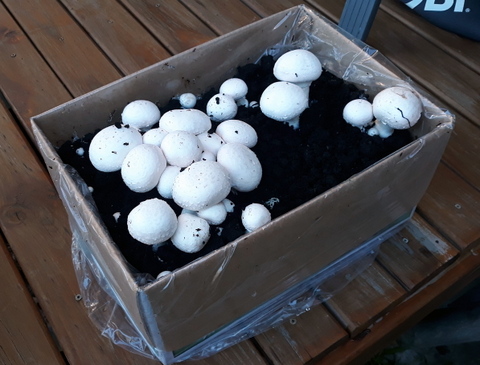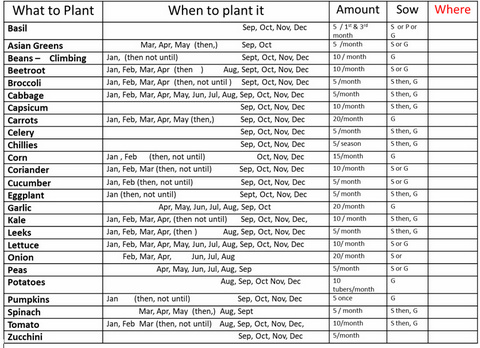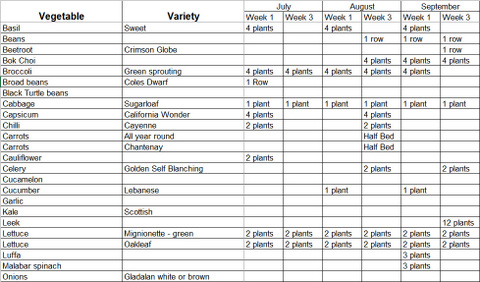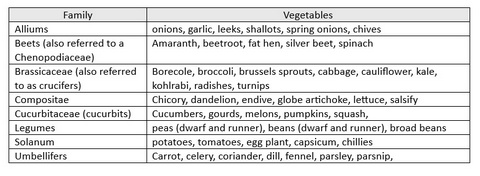Succession planting means “following one plant with another” or sowing seeds at different times to ensure a continuing harvest. Succession planting allows you to maximise your Zone Zero food production in volume and variety for a given area by obtaining a yield all year round. A succession plan allows you to achieve that aim by setting up a framework which you can use to sow and plant out the veggies which will meet the needs of your family.
While succession planning has been traditionally associated with growing vegetables in the ground, it is also applicable to all aspects of farming Zone Zero. Whether it is growing vegetables or herbs in pots or other containers, growing sprouts or microgreens or growing mushrooms, it is all about setting up a process to ensure that food is growing throughout the year.
Creating The Plan
Decide what you want the plan to cover – Are you going to plan out your container grown veggies or sprouts and microgreens or maybe mushrooms, perhaps your vertical garden, or all of it? It is important to set the context of the system first so you can make sure the plan that develops from then on covers everything you want.

You can include mushrooms in your succession planting plan
List what foods you want to eat each year. A good way to start out is with a list of what you are eating now with the type and variety (if you know it) for vegetables. If you are only eating commercial veggies from Woolies this can be difficult. If you buy your veggies from a fruit and veg shop, organic shop or growers market ask the proprietors/growers if they can help you find out. Do you currently eat other foods like sprouts, microgreens, shoots and mushrooms? If you want to grow something you have not tried before (such as the aforementioned sprouts, vegetables, mushrooms or whatever) I suggest buying some commercially produced examples and try them on yourself and your family. If they are accepted, you could include them in your plan, if not, better to know now than after growing a bumper crop! With crops like sprouts, they only take a week to produce so you can raise you own and give them a go to check them out for flavour etc.
At this point it may be worth doing some research. Hit the books, the seed catalogues and the net and see what varieties are grown in or near your area/climate zone. Local growers, especially backyard growers can also provide a mine of information on what varieties do well in your area and are worth eating. Your local permaculture group are also worth talking to, if you are not already a member.
Work out when in the year each vegetable grows - generally, this information will be far less important for growing in Zone zero that if you were growing outdoors in beds. It will be more important to determine if the veg are warm season or cool season growers so that microclimates can be taken advantage of (or developed) to provide the best growing environment. (Check out the article on Zone Zero microclimates). In contrast, sprouts, microgreens, shoots and mushrooms will grow all year round given the right conditions.
Estimate how much of each food you want to eat – This can be as complex or simple as you like. The numbers can be arrived at by keeping a food diary for year and entering what you eat each day in that, doing it for a month or two then extrapolating, or just sit down with the family and guesstimate how much veggies you will need.

One example of a succession sowing/planting plan
Work out how much growing area you have – If you have done an assessment of your Zone Zero, you will have some idea of the area you have to grow crops. Make sure to include areas near windows, especially north facing windows, plus patios, balconies and decks attached to the house plus any vacant flat spaces if you intent to grow under lights. More information on identifying areas for growing can be found here. Don’t forget to allow areas for crops like sprouts and mushrooms that don’t require light.
Draft the plan – now having an idea of how much you want to grow and how much area you can put aside for crop production, it is possible to draft a plan that allows you to grow what you want.
- Vegetables – this part of the plan will be a sowing guide that tells you how many seeds need to be sown when, to grow the number of seedlings required to keep up the supply for a year, taking into account the needs for cool and warm season crops.
- Sprouts, microgreens, shoots and soil sprouts – These are quick to go and quick to harvest so the plan can show the amount of sprouts and/or the area of microgreens and/or shoots will need to be sown and how often, to secure a regular supply.
- Mushrooms – These will take longer to grow than sprouts or microgreens but also less than most veggies, depending on the mushroom species grown and the substrate used, but they can crop in less than a month. Another aspect to be factored in is that mushrooms can provide four or five of flushes over a period of a few weeks.
The plan itself will look like your plan and make the most sense for your situation. Following are examples of vegetable sowing plans to help but don’t be afraid to have a go at developing your own from scratch.
Follow your plan – Ensuring that you put aside some time to follow your succession plan is well worth the effort. What I did find was that if I did forget or got distracted, the effect was not immediate but a couple of months down the track yields began to suffer and plants which I should be starting to harvest were just not there. Obviously the effect of not setting up sprouts or microgreens according to your plan will have a much more immediate effect.
Record your harvest, to plan for next year – It is very rare to get anything right first time around, so record any successes and failures and review your plan once you have been following it for 12 months. Even if you adjust your plan on-the-run during the year, an end of year review of what worked, and what didn’t, can help you improve your plan year on year.
Choose Your Varieties
By reviewing seed catalogues and other data it will become obvious fairly early that some veggies such as tomatoes will have hundreds of varieties whereas others such as Brussels Sprouts may only have a one or two. Having a large number of varieties is good because it means you have some choice over what you grow and eat within the broad heading of each vegetable.

Another format for a succession sowing/planting plan
However, the large number of varieties can make it difficult decide on which ones to grow and while it is very much a personal decision, here is some information that may help you decide -
Early, main crop or late? –Some vegetables have been bred to be harvested early in the season and so have a shorter time between sowing and harvest. Some even have the word ‘early” in their name which is a dead giveaway, eg Early Jersey Wakefield cabbage, Early Scarlet Horn carrot or Phenomenal Early cauliflower but mostly the data from the seed catalogues will point you in the right direction. While this will have an impact on Zone Zero farming it will be somewhat less than outdoor farming.
Growing Habit: Determinate vs indeterminate – a few vegetables, such as tomatoes, peas and beans contain varieties within their ranks that will grow, mature and be harvested within a specified time and a defined plant size. These are referred to as having a determinate growth habit, also referred to as “bush” or “dwarf” varieties whereas other varieties of the same plant may continue to grow throughout the season. These varieties are referred to as indeterminate, also referred to as “climbing” or “staking” varieties and these will produce for as long as the soil and climatic conditions will allow. Indeterminate is generally better for places like balconies or patios in the Zone Zero farm whereas determinate is better for indoor growing, unless you have plenty of room!
Flavour (and other attributes) will vary between varieties – back when I first started growing our own veggies and the kids were a lot younger, I was getting a good response from everyone for the dwarf stringless beans I was growing. I wanted to increase my production, so I went from dwarf to climbing beans. The kids HATED them and refused to eat them, so it was back to the drawing board. You may want to try out a few varieties of each veggie before you settle on which ones you want to grow, or even try before you buy if possible, but keep the family involved!
Ask what varieties are grown in your area – Again, talking to other backyard growers about what varieties they grow and why, what varieties do well in the area, what ones are particularly tasty, or keep well or both. This is a bit less important for the Zone Zero farmer because of your ability to control the environment a bit more as compared to outdoor growing. Don’t lose heart if there are no backyard/indoor growers in your immediate area. See if there are any community gardens in the area and talk to growers there, contact your local permaculture or seed savers group for advice too.
Crop Rotation
It is bad cultural practice to grow the same veggies in the same growing medium, season after season, year after year and especially so if you are using containers and pots rather than beds. Over time you get a reduction in soil fertility (the same plants take out the same nutrients each time they are grown) and may get a build-up of pests and diseases. I have seen a number of crop rotation plans, but the one that makes the most sense to me for use in the Zone Zero farm is simply not to plant from the same vegetable family, in the same containers, in successive crops.
Following is a list of the plant families and the major vegetables that come from each one. You can include this in your planning, but it is simple enough to carry out ad hoc at sowing time.

Conclusion
Once a succession plan has been developed, it can be included with the information uncovered during the Zone Zero assessment, the balcony assessment (if needed) and the zone zero microclimate review and used to develop a wholistic Zone Zero plan for implementation.
Developing and Implementing the plan will be covered in a later article in this series.


